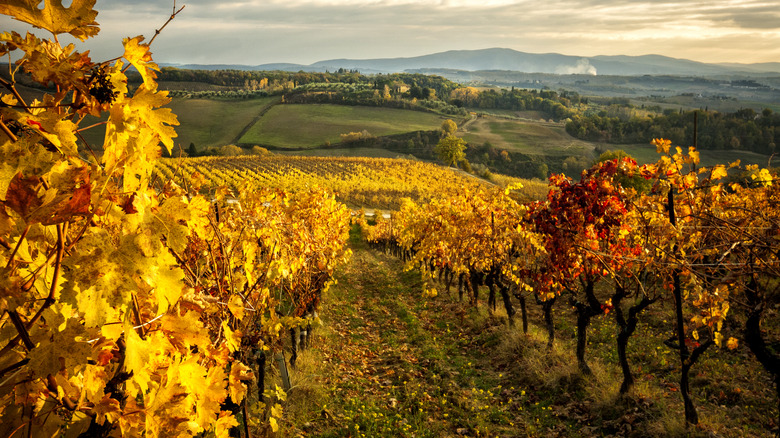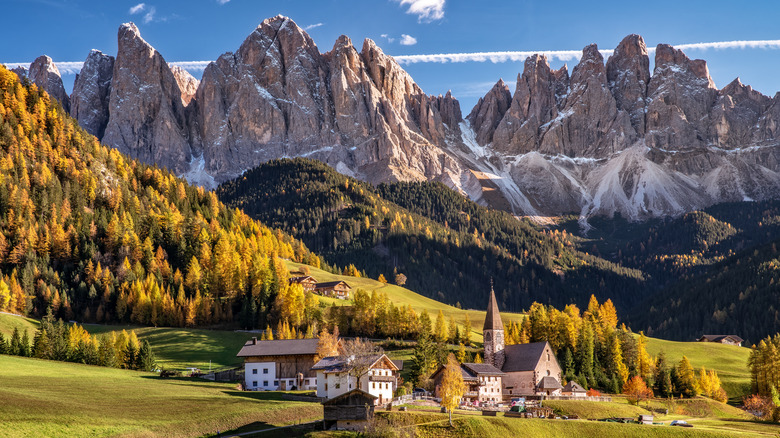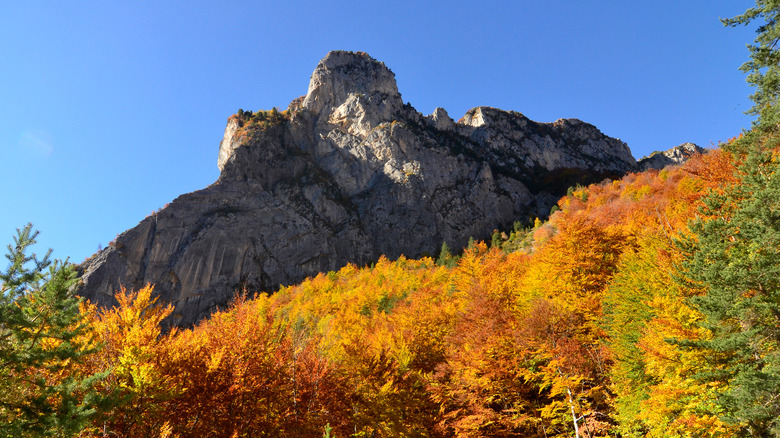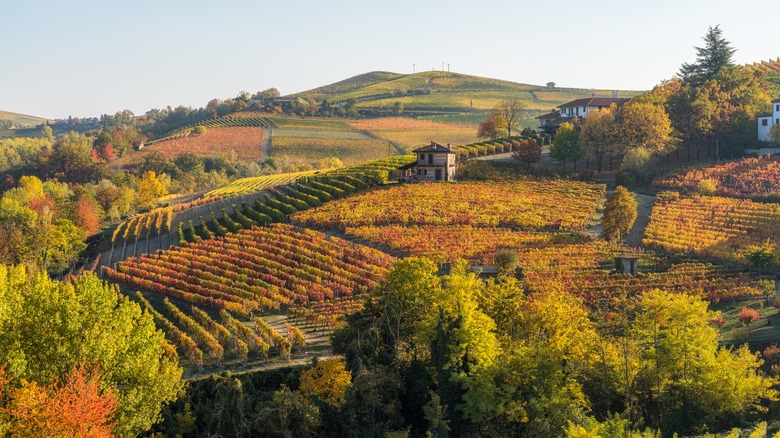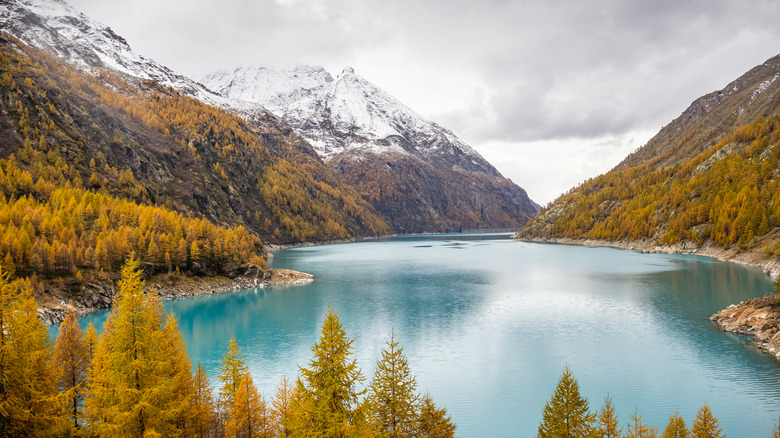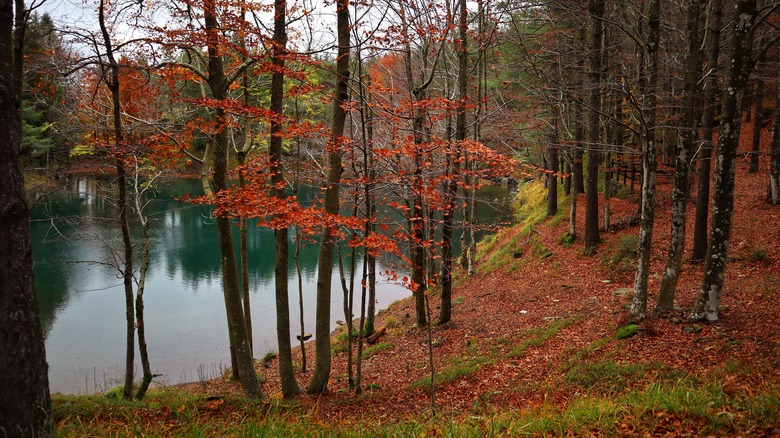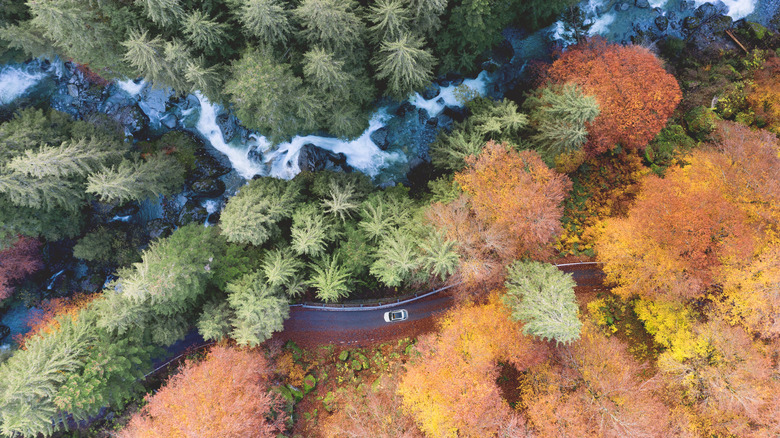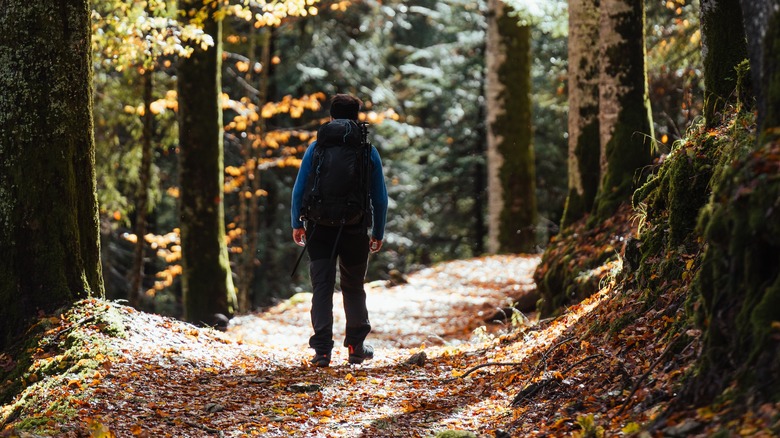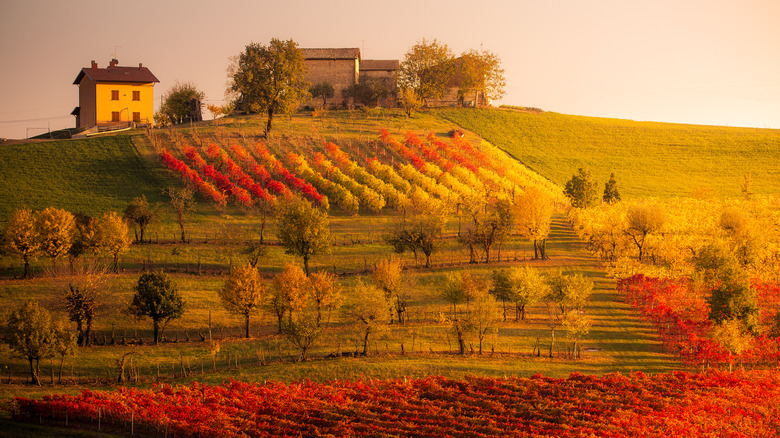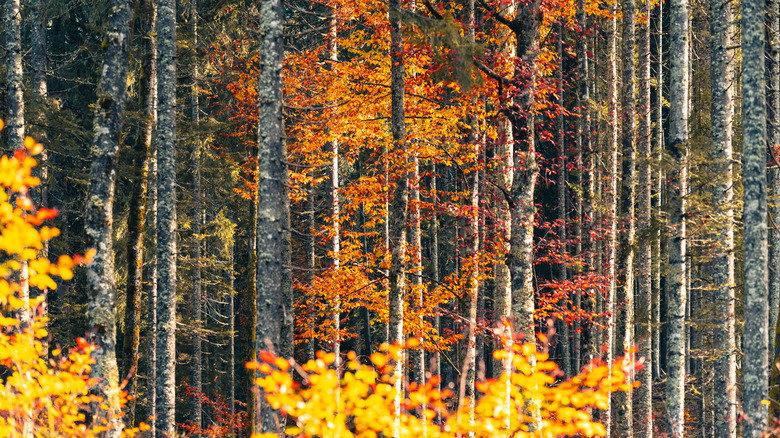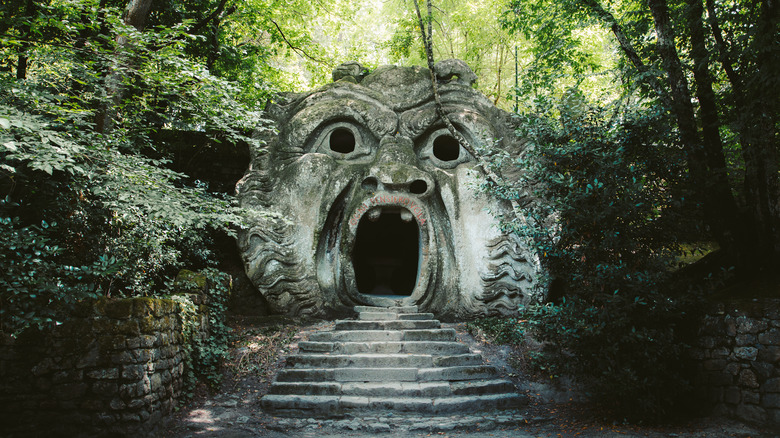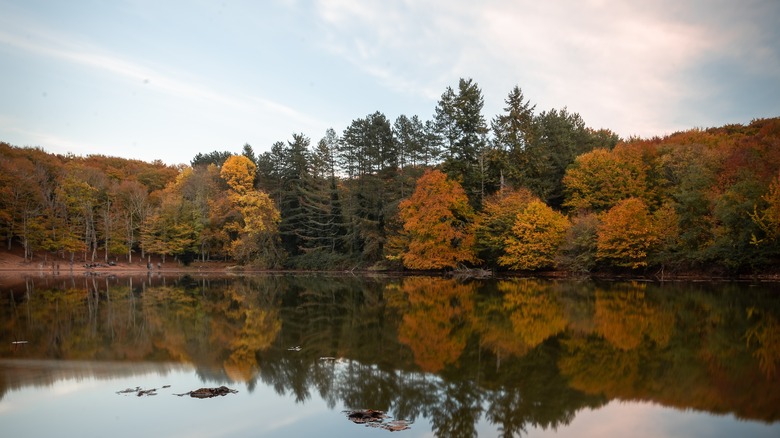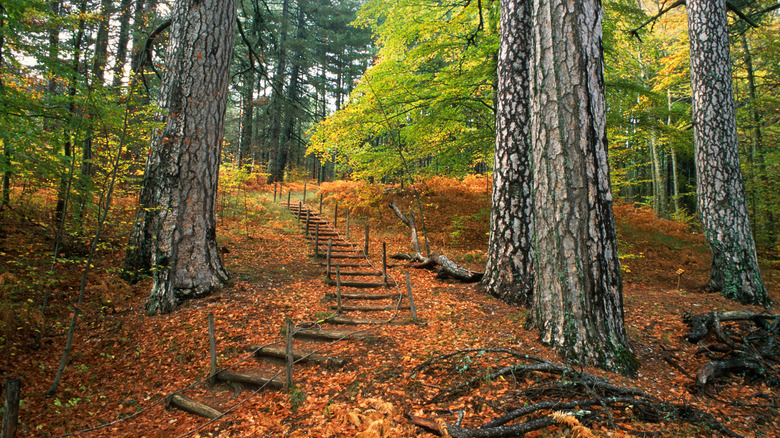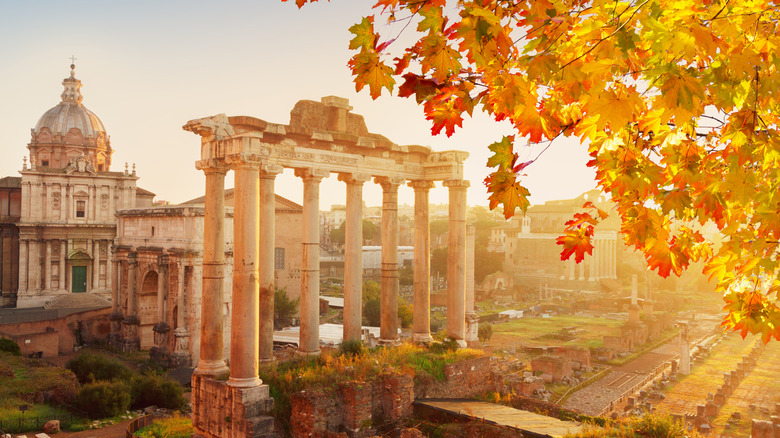Destinations Across Italy With Unparalleled Fall Foliage Views, According To Research
When we think of fall foliage, we reminisce about the captivating scenery along New York's Hudson River Valley or the rolling hills of the iconic Blue Ridge Parkway. We don't think of Europe so much, even though the continent is home to some of the oldest preserved woodlands in the world. We're even less inclined to consider Italy as a prime destination for fall foliage. This would, however, be a mistake.
Italy is more than medieval squares and stunning Amalfi Coast beaches. Though smaller than California, it is one of the most geologically diverse nations in all of Europe. Travelers can go from snow-covered Alpine scenery in the north to hot sun and sand in the south. In between, there is a whole range of forests, farms, vineyard-covered hills, lakes, and mountains. That's where you'll discover landscapes teeming with truly stunning fall foliage.
While much of Italy's leaf-peeping glory is concentrated in the north and central regions, you can find great foliage destinations as far south as Calabria! As our research shows, visiting Italy for a fall foliage tour is one of the savviest and most beautiful trips you can make. So, join us on this autumn ride down the Boot!
The Dolomites
In the far north of Italy exists a mountainous landscape more reminiscent of neighboring Switzerland. These are the Dolomites, a range of tall, limestone mountains dotted with small, picturesque villages, enormous Alpine meadowlands, and a unique culture of its own. Stretched across the regions of Veneto, Trentino Alto-Adige, and Friuli Venezia Giulia, the Dolomites are home to some of Italy's most pristine hardwood forests, which come alive with color when autumn arrives.
Though Italy is mostly known for its ancient olive groves and the cypress that line Tuscan roadways, there are a great number of hardwood trees that showcase color during the fall. Chestnut, European beech, oak, flowering ash, and maples all burst with spectacular arrays of yellow, orange, red, and even purple. These trees form the wooded base of the Dolomites, providing stellar fall views to visitors.
There is no specific town or place that offers better Dolomite foliage than the other. The key is to arrive earlier rather than later. The colder temperatures and higher elevation cause the leaves to start changing in mid-September. So, a visit in October or early November will be your best bet for catching some of the most dramatic foliage in Italy.
Monti Biellesi, Piedmont
Italy has 20 administrative districts, each with its own landscape and culture. Piedmont is in the northwestern corner of the country. Home to the iconic city of Turin, the region is a mixture of valleys and mountains that make for one of the most breathtaking natural landscapes in Italy. Just watch any of Martijn Doolaard's YouTube videos to see proof of Piedmont as the ideal place to catch fall foliage.
Though plenty of forests are scattered throughout the region, one place guarantees the best foliage year after year. Monti Biellesi, a World Wildlife Foundation site, is a conservation area and an amazing place to view native wildlife and appreciate the foliage of the surrounding hillsides. The mountains, part of the Northwestern Pennine Range, offer stunning peaks and trails for foliage-loving hikers.
If you've got the time, we recommend trying your hand at an Italian farmstay on one of the many farms that dot the Piedmont hills. You will get first-hand knowledge about the season's harvest and witness oaks, maples, beech, and chestnut trees changing from green to various shades of red, orange, and yellow. Plus, think of the food you'll get to eat!
Le Langhe, Piedmont
Heading southward into the hills and valleys of Piedmont is a place known as Le Langhe. This is a famous destination for those who consider themselves foodies. Le Langhe is noted for its excellent cuisine and wine. While Tuscany may be the best Italian destination for wine lovers, Le Langhe produces some of the finest full-bodied red wines, like Barolo and Barbera, in the country. Paired with regional delicacies, such as black truffles, brasato, and rabbit stew, Le Langhe's cuisine is the perfect companion for stunning foliage.
In the fall, the leaves on the grape vines and the surrounding forests burn in brilliant shades of red, orange, and yellow. It's a true delight to be sitting in a vineyard, sipping some excellent wine, and watching the hills roll by with these amazing colors. It's almost like an ocean of vibrantly shaded leaves.
However, the area is at its most beautiful in the mist. As the cooler weather starts, a thin mist descends from the mountains onto Le Langhe, creating a bewitching atmosphere. The muted colors are somehow more eye-catching through the fog. Wandering through this region is like stepping into a dream. It's a one-of-a-kind experience.
Monte Bianco, Valle D'Aosta
The Valle D'Aosta region is a small, sparsely populated place tucked into the extreme northwestern corner of Italy. What it lacks in population, iconic cities, and a well-known culture, it makes up for in natural might. The Alpine mountain scenery here is some of the most dramatic in the entire country. Therefore, in terms of fall foliage, Valle D'Aosta offers some of the most pristine forest landscapes.
One such place is Monte Bianco. Also known in French as Mont Blanc, this iconic peak is the highest in all the Alps. The surrounding area on the Italian side of the mountain is Val Ferret. It is a picture-perfect site for a fall adventure — the snow-capped Monte Bianco is set brilliantly against the golden light emitting from the regional larch trees. The multitude of hiking paths and winding roadways make the area easily accessible to visitors longing to experience some truly amazing Alpine scenery.
Valle D'Aosta's cured meats and bold red wines offer yet another perfect accompaniment to the fall weather. Fill your backpack with local motzetta, teteun, or boudin, a hearty cheese, and a good red wine. Take this on one of your hikes, and enjoy Italy's version of a ploughman's lunch on an outcropping overlooking a mountain lake. You surely won't be disappointed.
Monte Beigua Regional Park, Liguria
The region of Liguria is most known for being home to Italy's stunning Riviera. Breathtaking coastal hillscape villages like Vernazza, which Rick Steves calls the jewel of the Cinque Terre, are among the most popular tourist destinations in the entire country. So you could be forgiven for thinking there would even be tourists in this area once summer has passed. Savvy travelers know that September to November is one of the best times to visit the Mediterranean. Avoiding the massive crowds means experiencing the Ligurian hill country in the fall.
The best place to visit is Monte Beigua Regional Park. A UNESCO Global Geopark, Monte Beigua is a mixture of landscape features, including outcroppings of rocks, fields, and forests. Its proximity to cities like Genoa makes Monte Beigua ideal for a day trip, and you won't be disappointed with the park's fall colors. Many of the hiking paths in the park are lined with broadleaf trees like oak, ash, and chestnut, which turn a burned yellowish brown, red, and orange before falling to the ground. When these pale leaves catch the light, they shimmer with life. This offers just as much color as the pastel-painted homes of the Riviera below.
Val Masino, Lombardy
Lombardy, with its capital city of Milan, is one of the wealthiest and most visited regions in Italy. Despite being known as one of the more dangerous Italian destinations, there are plenty of things to do in Milan, including seeing the city's trees change color in the fall. Yet, if you're looking for a bit more fall foliage but don't want to venture too far from the amenities of the city, then you should visit the Val Masino.
Formally known as the Bangi di Masino, this forest on the outskirts of Milan is one of the most convenient places for visitors to experience the glory of Lombardy's fall foliage. A thickly wooded, shady forest with mossy knolls and thick undergrowth, Val Masino is filled with pools, streams, and waterfalls. Thanks to its position at the base of the Lombard Alps, glorious peak views can be seen from fields comprising babbling brooks.
The canopy of this forest is a mix of birch, oak, maple, chestnut, pine, and beech. The floor is often coated with dried pine needles, which only serve to amplify the colors of the surrounding vibrant leaves still clinging to the branches above. It's a great location to see stunning foliage without sacrificing natural landscape views.
Bosco del Cansiglio, Veneto
Like Lombardy, known for Milan, and Piedmont for Turin, the city that everyone flocks to when they are in Veneto is Venice. This steadily sinking city in the lagoon is an iconic testament to romance and brilliant engineering but offers extremely little in the way of fall foliage. Thankfully, the surrounding Veneto landscape is a veritable playground of forests, vineyards, and glens. The Bosco del Cansiglio is the place you will want to visit for the best fall foliage in the area.
The Cansiglio is the second largest protected forest in all of Italy and breaks up the monotony of the peneplain it grows out of. Teeming with oaks, maples, chestnut, beech, and ash trees, the colors that come out of these woods are worthy of their own paint colors by Benjamin Moore. Though the nearby Dolomite mountain range is filled with hiking trails, the paths through the Cansiglio are perfect for those less able to handle the altitudes of the mountains. This makes the forest very easily accessible to all levels of hikers. Additionally, thanks to nearby townships, restaurants, hotels, and the region's world-famous Prosecco are not too far away either.
Colli Piacentini, Emilia Romagna
Heading down into central Italy, we come to the misty landscape of Emilia Romagna. One of the widest regions of Italy, Emilia Romagna has a coastline along the Adriatic Sea to the west and meets up with the Apennine Mountains as they begin in the Ligurian foothills in the east. While coastal towns like Ravenna and Rimini offer charms in terms of clubs and beaches, for fall, you're much better off exploring inland at the Colli Piacentini.
This area is defined by its rolling hills, small forests, and abundant vineyards. Located in the northeastern corner of Emilia Romagna, near the border with Lombardy, the area is fed by the mighty Po River and several of its tributaries. It's a fantastic place for growing grapes for wine and farming the pigs that make the region's famous cured hams.
Though much of Emilia Romagna is plains, the forests that dot the Colli Piacentini come alive with color in the autumn. The depth of color of the trees set against the violent reds of the grape vines heading into dormancy is a photographer's dream. The forests are filled with beech, oak, ash, and maple, creating a kaleidoscope of color that should not be missed by any traveler in the region.
Foreste Casentinesi, Tuscany
Autumn in Tuscany means two things: thick, meaty stews and the olive harvest. While these are occurring, steady mists are setting over the hill towns, wine vineyards are going dormant, and the smell of wood-fired ovens thickens the air. It's a time when Tuscans are preparing for winter, but the autumn traveler gets the opportunity to see the surrounding forests burst with drama before heading into hibernation.
The Foreste Casentinesi is an Italian National Park that serves as a pure wilderness oasis in northern Tuscany. Just a few hours north of Florence, Casentinesi is a haven for animals like the famous Tuscan wild boar, roe deer, and wolves. It's also filled with small waterfalls and pools, tall peaks that offer expansive views of the park, and even a working monastery.
As far as fall foliage goes, the natural hardwoods of the forest make for a truly stunning display of Tuscan autumn color. It's a great time of year to visit Tuscany as well. The crowds are much smaller, you're bound to catch a harvest festival or two, and the colder weather will make a trip to one of the region's hidden hot springs all the more pleasant.
Sacro Bosco, Lazio
This is by far the most unusual forest park on this list. The Sacro Bosco, or Sacred Forest, in Lazio is equal parts forest and sculpture park. Filled with statuary that ranges from the romantic to the downright bizarre, the Sacro Bosco is one Italian fall foliage experience you're not soon to forget. The park was originally commissioned by Prince Pier Francesco Orsini in the 1500s. The present Sacro Bosco is the remnants of what was once an enormous garden of Renaissance Italian royalty. Once the Prince died, the garden was abandoned, only to be rediscovered in the mid-20th century. Imagine the homeowners' shock when they came across multiple granite statutes in their new overgrown garden.
Open to the public, the Sacro Bosco is no longer a curated garden but rather a forested maze of conifers and deciduous trees. The colors brought on by fall only serve to enliven the statuary, providing them with an even more mythical presence. A decent distance northwards from Rome, the Sacro Bosco would make for an excellent day trip for anyone looking to see one of the more peculiar foliage destinations in the country.
Foresta Umbra, Puglia
Though Puglia is primarily known for its white-washed homes and unforgettable beaches, there are areas of the Boot's heel that offer their fair share of surprises. Such is the case with the Foresta Umbra. You will see this forest listed on every Italian fall foliage destination travel guide, and for a good reason. It's a shock to most visitors that there is even a place like this in Puglia, whose landscape is more plain than forest.
Located in the north of Puglia near the border with Molise, the Foresta Umbra is not overly large, but it has a sizable impact on visitors. At around 10,000 hectares, the forest is among Italy's smallest, but it is filled with amazing flora and fauna. Multiple paths link together to form a trail system that takes you through the woods.
Thanks to a phenomenon known as macrosomatism, the oaks, beeches, and pines here grow to absolutely enormous sizes. So, towering above you could be a veritable inferno of fall color, amplified by the massive size of the trees and their brilliant leaves. And, in a region known for its excellent cuisine, you can congratulate yourself for visiting this hidden gem by tucking into a plate of pasta.
Parco della Sila, Calabria
Calabria is in the deep south of Italy, the final extension of the boot. Along with Molise and Basilicata, they are among Italy's forgotten regions. Calabria, however, is steadily being rediscovered by tourists who come for its smaller crowds and, arguably, more purely authentic Italian culture. The landscape of Calabria does not encourage foliage. It is rocky, arid, dry, and relentlessly hot. Still, there is one place that you can go for some truly stunning fall colors.
Silla National Park sits in the northern section of Calabria and is a mountainous area with much more vegetation than the more southerly hills. The park is filled with maples, oaks, chestnuts, and beech trees, creating a color palette for fall that will make you feel like you're somewhere in New England as opposed to southern Italy. If you want to come to a place that is pleasantly surprising and is in an area that is really more off the beaten path for Italian travel, Silla National Park is the place to visit.
Methodology
While fall happens everywhere, the key to experiencing autumn foliage is to visit the places that offer a colorful experience — where you can feel the season and see it occur. So, for the Italian peninsula, these are the best regions and cities to experience that foliage. The research for this list was based on several sources, including regional tourist websites, magazines, newspapers, travel blogs, and foliage finder sites. Our goal was to present the finest fall foliage scenes in the Boot country that are worth visiting. These sites also have incredible natural landscapes and delicious meals you can enjoy after checking off every item on your leaf-peeping bucket list.
